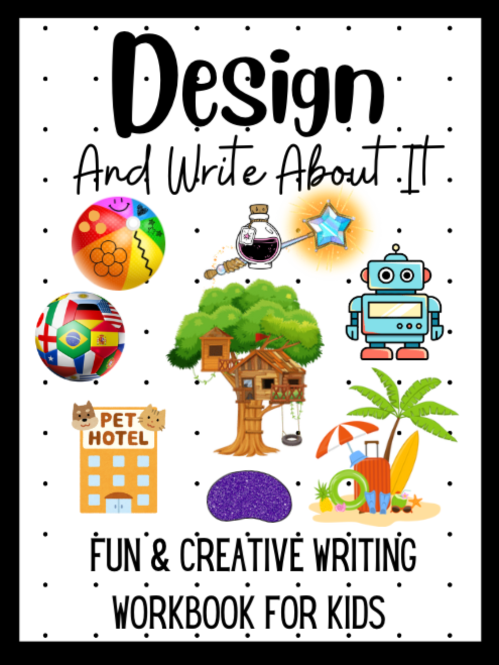Getting kids excited about writing can be a challenge, but with the right approach, it can become a fun and rewarding activity. Here are steps to spark creativity and ways to make writing more fun for kids:
Step 1: Provide a Stimulating Environment
Create a space where kids feel comfortable writing. Provide them with journals, notebooks, pens, mechanical pencils and a quiet place to think. Switch it up and write in different places; make a fort, write under a table or outside.
Step 2: Read Regularly
Expose children to a variety of books and stories. Reading widely can inspire their own writing and introduce them to different styles and genres. Ask kids to write different versions of the favorite stories they read.
Step 3: Set Fun Writing Prompts
Give kids fun and engaging prompts to spark their creativity. Prompts like “Write about a day in the life of a superhero” or “Imagine a world where animals can talk” can be very stimulating. Writing can take kids places they can’t go.
Step 4: Encourage Sharing
Create opportunities for kids to share their stories with others. This could be through family reading nights, school assignments, or writing clubs. Don’t forget to celebrate their work by displaying their stories at home. Celebrate their efforts to show that you value their creativity and hard work.
By encouraging creative writing, you’re not only helping children develop important skills but also providing them with a powerful tool for self-expression and creativity.
Ways to Make Writing Fun for Kids
Provide Fun Writing Opportunities
Design & Write About It Creative Writing Workbook for Kids: Use dice with pictures or words on each side. Kids roll the dice and use the images or words to create a story. This random element can spark creativity and lead to surprising and fun storylines.
5.0 out of 5 stars “Top Notch Creative Writing Workbook”
–As an Education Consultant who has a passion for improving writing by engaging children in the task, I am thrilled that this book offers an opportunity for young writers to be as creative as they wish. Too often, children are told what to write and not given the autonomy to be an individual. While this book provides some direction by asking the writer to reflect on various questions, this structure provides information about what needs to be considered in various text types and so allows some reflection on elements such as descriptive language, sequence, persuasion, etc.
Interactive Writing Games
- Story Cubes: Use dice with pictures or words on each side. Kids roll the dice and use the images or words to create a story. This random element can spark creativity and lead to surprising and fun storylines.
- Round Robin Stories: In a group setting, have each child write a sentence or two of a story before passing it to the next person to continue. This collaborative approach can result in hilarious and unexpected tales, keeping kids engaged and entertained.
- Writing Prompts Jar: Fill a jar with various writing prompts on slips of paper. Kids can draw a prompt from the jar and write a story or a few paragraphs based on the prompt. This adds an element of surprise and can help spark their imagination.
Technology and Multimedia Integration
- Digital Storytelling: Encourage kids to use apps or websites that allow them to create digital stories. These platforms often include features for adding images, sounds, and animations, making the writing process interactive and fun.
- Blogging: Set up a simple blog for your child where they can publish their stories and share them with family and friends. The idea of having an audience can be motivating and exciting.
- Video Scripts: Have kids write scripts for short videos or skits. They can then film their stories using a smartphone or tablet. This process not only makes writing fun but also integrates other skills like acting and video editing.
Incorporate Art and Crafts
- Story Collages: Have kids cut out pictures from magazines or draw their own illustrations to create a visual collage that represents their story. They can then write a story based on the images they’ve collected.
- Decorated Journals: Provide kids with plain notebooks and a variety of art supplies (stickers, glitter, markers, etc.) to decorate their own journals. A personalized journal can be a fun place for them to write their thoughts and stories.
- Comic Strips: Encourage children to create their own comic strips. This allows them to combine drawing and writing, making the storytelling process more dynamic and visually appealing.
By incorporating art, interactive games, and technology, you can make writing a fun and engaging activity for kids, helping them develop a love for storytelling and creativity.
The Benefits of Creative Writing for Kids
Creative writing is an incredibly valuable activity for children, offering a wide range of benefits that go beyond just the joy of storytelling. Here are some of the key benefits of encouraging creative writing in kids:
1. Enhances Imagination and Creativity
Creative writing allows kids to explore their imagination and come up with original ideas. This freedom to create new worlds, characters, and scenarios helps to foster a love for creativity and innovation.
2. Improves Communication Skills
Writing stories helps children learn how to express their thoughts and ideas clearly and effectively. This skill is crucial not only in academics but also in everyday communication.
3. Boosts Confidence
When children create their own stories and see their ideas come to life on paper, it boosts their confidence. They learn to value their own thoughts and feel proud of their creations.
4. Develops Critical Thinking
Crafting a story involves planning, problem-solving, and organizing thoughts. Kids learn to think critically about how to develop plots, create believable characters, and resolve conflicts.
5. Enhances Academic Skills
Creative writing supports the development of essential academic skills such as grammar, punctuation, and spelling. It also encourages a broader vocabulary as kids search for the right words to express their ideas.
6. Encourages Emotional Expression
Writing can be a therapeutic outlet for children to express their emotions and thoughts. It helps them process feelings and experiences, contributing to better emotional health.
7. Cultivates a Love of Reading
Creative writing often goes hand-in-hand with a love of reading. When kids write stories, they gain a deeper appreciation for the books they read, understanding the effort and creativity involved in creating them.
8. Promotes Empathy
Creating characters and imagining their experiences can help children develop empathy. They learn to see things from different perspectives and understand the feelings and motivations of others.
9. Strengthens Focus and Discipline
Writing requires concentration and discipline. By working on their stories, children practice focusing on a task and seeing it through to completion, skills that are beneficial in all areas of life.
10. Encourages Independent Thinking
Creative writing encourages children to think independently and make decisions about their stories. This helps them develop a sense of autonomy and self-reliance.
So there you have it, how to effectively spark creativity in writing for kids, make it fun and celebrate writing!
Happy writing.

